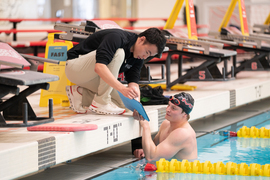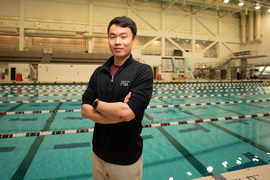“All I did was swim,” says Jerry Lu, recalling his teenage years as a competitive swimmer. “From age 12 to 19, it was close to 30 hours a week of training.” Although Lu no longer competes himself, his understanding of the dedication and impeccable technique required in elite sports continues to shape his path as a master’s student at the MIT Sloan School of Management.
As an undergraduate at the University of Virginia, Lu majored in systems and information engineering and economics. He had stopped swimming competitively, but he stayed connected to the sport as a technical performance consultant for the university’s nationally ranked swim team. Under his advisor, Ken Ono, Lu built a methodology of analyzing data from sensors worn by swimmers to improve their individual performance. By looking at an athlete’s propulsion and drag data over the course of a race, Lu can advise them on where they can shave off tenths of a second simply by adjusting their stroke to be more efficient.
That experience inspired Lu to pursue a career in other aspects of sports. At MIT he’s pursuing a master’s in finance to build the analytical skills necessary to enable the sustainability of sports that don’t already enjoy the major commercial success of, say, football or basketball. It’s especially a challenge for Olympic sports, such as swimming, which struggle for commercial ventures outside of Olympic years.
“My work in swimming is focused on athlete performance to win, but the definition of winning is different for a sport as a whole, and for an organization,” Lu says. “Not only do you need to win medals, a big part of it is how you allocate money because you also need to grow your sport.”
At MIT, Lu is building a playbook for high-performance sports from both an athletic and financial perspective. He’s been gaining exposure to additional elite sports by working with MIT’s Sports Lab under Professor Anette “Peko” Hosoi. His work there isn’t a requirement for his master’s program, but Lu appreciates that the program’s flexibility allows him time to pursue research that interests him, alongside the required curriculum.
“I’m quite lucky to be here in the sense that MIT is known to train great people in engineering, science, or business, but also people with unique passions,” says Lu. “People that love football drafting, people that love to understand how you throw a curveball — they use their knowledge in very unexpected ways, and that’s when innovation happens.”
Lu’s research with the Sports Lab focuses on optimizing strategies for aesthetic sports, such as figure skating or snowboarding, which are judged very differently than swimming is. Instead of figuring out how to move faster, athletes are interested in structuring routines that net them the most points from a panel of judges. Modelling techniques can be helpful for figuring out how to put together routines to maximize an athlete’s abilities, and also to predict how a judge might assign points based on how or when a skill is demonstrated. Optimizing both athletic performance and judge psychology is a challenge, it’s this type of innovation that excites him. He hopes more sporting organizations will adopt similar data-driven strategies in the future.
When asked where he’d like to end up after finishing his degree, “The sport industry is the natural choice,” Lu says. Though he is certain his career will lead to sports eventually, he is still open to exploring new paths. This summer he will be a trading intern at Citadel Securities to apply the concepts learned in his degree program courses. He’s also picked up sailing since coming to MIT, already reaching the highest amateur rating in under a year. Lu consistently strives for excellence, whether in himself or for those he works with.
Since graduating from UVA, Lu has continued to work with swimmers, including national champions and Olympic medalists, as a technical performance consultant. He’s also branched out into another Olympic sport, triathlon. Lu describes it as a side gig, but he’s deeply invested in the athletes he works with, even taking trips to the Olympic Training Center to collect data and help them build strategies for improvement.
“The most fun part is actually interacting with the athletes and engaging and understanding how they think,” says Lu. “It’s easier for me to do so than others, because if you’ve never swam before and you’ve never trained as an elite athlete before, it’s hard to understand what exactly you can and cannot do and how to communicate these things to a coach or an athlete.”













